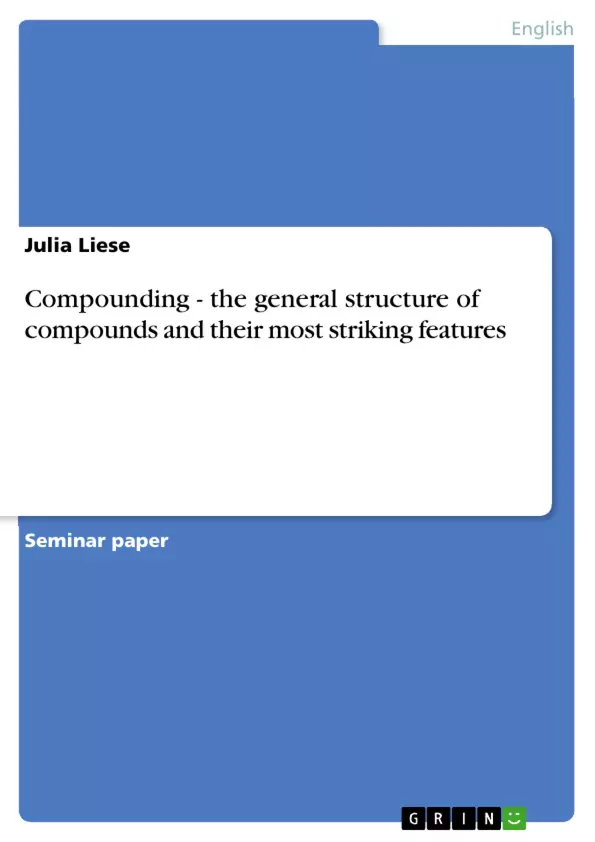Is a green house a glass building to grow plants in, or simply a green colored house? And if nurse shoes are shoes for a nurse, are alligator shoes, shoes for an alligator? Ambiguity is a huge problem in almost every language, but ambiguous words can often be explained, when taking a closer look at how they were compounded.
In the context of word-formation, the process of compounding plays a major role in English, as well as in many other languages. Since compounding is, next to affixation, one of the two most important derivation processes, it is reasonable to take a closer look at it. Therefore this paper will examine the structure and the features of English compounds. I will begin with a definition of compounds in general, before illustrating compound stress patterns, recursivity, headedness and the binary structure of compounds. Then I will analyze the most important classes of compounds and investigate the different possibilities to link nouns, verbs, adjectives and prepositions. Besides that, I will present some ways how to interpret certain compounds and show some exceptions. Furthermore, I will present other forms of compounds, as neoclassical and copulative compounds, and examine their structure as well. As a final point I will close this paper off with concluding remarks.
Inhaltsverzeichnis (Table of Contents)
- 1. Introduction
- 2. Compounds in General
- 2.1. What is a compound?
- 2.2. Stress
- 2.3. Recursivity
- 2.4. Head and Modifier
- 2.5. Binary Structure
- 3. Major Compound Types
- 3.1. Nominal Compounds
- 3.2. Adjectival Compounds
- 3.3. Verbal Compounds
- 4. Other Compounds
- 4.1. Synthetic Compounds
Zielsetzung und Themenschwerpunkte (Objectives and Key Themes)
This paper provides a comprehensive analysis of English compound words, exploring their structure, formation, and various types. It aims to delve into the complex nature of compounding as a fundamental word-formation process in English, comparing it to other derivation processes like affixation.
- The structure and features of English compounds
- The role of stress patterns and headedness in distinguishing compounds from phrases
- The classification of compounds based on their heads (nominal, adjectival, verbal)
- The interpretation and exceptions within different compound types
- The analysis of other forms of compounds, such as synthetic compounds
Zusammenfassung der Kapitel (Chapter Summaries)
The introductory chapter defines compounds and sets the stage for examining the process of compounding in English. It discusses the combination of free lexical morphemes to create new words, highlighting the importance of the process in English word-formation.
Chapter 2 explores key characteristics of compounds, including stress patterns, recursivity, and headedness. It introduces the "nuclear stress rule" and the "compound stress rule" to differentiate compounds from phrases, and explores the concept of recursivity, where compounds can be combined to form even more complex words.
Chapter 3 delves into the classification of compounds based on their heads, focusing on nominal, adjectival, and verbal compounds. It examines the different ways in which words can be combined to create these compounds, as well as the rules governing their formation and interpretation.
Chapter 4 examines other types of compounds, including synthetic compounds. It discusses the structure and interpretation of these compounds, highlighting the importance of understanding how they are formed and how they contribute to the richness of the English language.
Schlüsselwörter (Keywords)
This paper focuses on key concepts such as compounding, word-formation, lexical morphemes, stress patterns, headedness, recursivity, nominal compounds, adjectival compounds, verbal compounds, synthetic compounds, binary structure, and grammatical information.
- Quote paper
- Julia Liese (Author), 2009, Compounding - the general structure of compounds and their most striking features, Munich, GRIN Verlag, https://www.grin.com/document/174547




